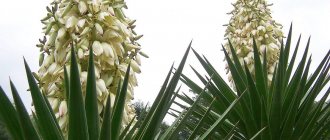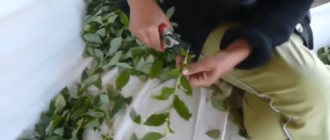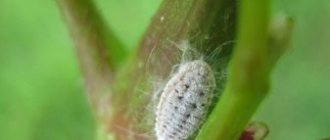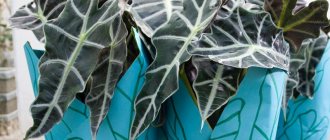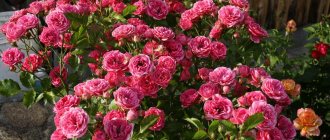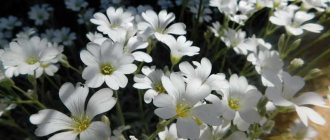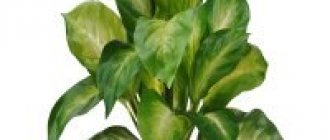Types and varieties for growing at home
There are a number of varieties of akalifa that can be grown indoors. Below you can see photos of the plant; you can make excellent bouquets from them.
| View | Description |
| Wilks | Shrub one meter high. The stem is copper-red in color and has fibers. The length of the leaves is 20 cm, width - 15 cm. The foliage is bronze, there is spotting of copper or light pink color. |
| Bristly haired (hispida) | It has bright green foliage, the inflorescences of the bristle-haired foxtail are 35-40 cm long and colored crimson and scarlet. |
| Indian | Shrub up to half a meter high, weak branching. The leaves reach a length of 4-6 cm, with 5 veins at their bases. Flowering is short - from July to March. |
| South | It reaches half a meter in height, has ribbed shoots that are covered with sparse, but hard-to-touch hairs, and are highly branched. The foliage is thin and 4-5 cm long. It blooms in July and August. Has axillary inflorescences. |
| Haitian | The foliage is heart-shaped, 3 to 4 cm long, light green in color. Inflorescences range in size from 4 to 10 cm. In an apartment it is usually grown as an ampel plant, that is, in a flowerpot. |
| Godsefa | A hybrid with foliage in the form of a wide oval, up to twenty centimeters long. The color is copper-red or golden. |
| Californian | The foliage is light green in color and has large teeth along the edges. The color of the inflorescences is deep pink. |
Types of Akalifa
Acalypha bristly or rough acalypha Acalypha hispida syn. Acalypha sanderi
Fatsia

Acalypha bristly or acalypha bristly hairy Acalypha hispida syn. Acalypha sanderi photo
The most popular decorative flowering species. The stems reach a length of about half a meter, they are densely covered with carved leaves and are full of velvety burgundy inflorescences. There is a variety with snow-white inflorescences.
Wilkes's Akalipha Acalypha wilkesiana
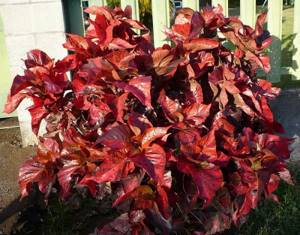
Akalifa Wilkesiana Acalypha wilkesiana photo
It is valued as an ornamental deciduous plant, although it also blooms. The evergreen leaves with carved edges are very large, 20 cm long and slightly less wide. The leaf plates are covered with patterns and uneven spots. The inflorescences are almost invisible, they look like threads or whips, gracefully hanging between the colorful leaves.

Acalypha chamaedrifolia, Haitian or Spanish Acalypha hispaniolae photo
Refers to decorative flowering species. Lush bushes are no more than 25 cm in height, the shoots are flexible. The inflorescences-tails are fluffy, about 3 cm in diameter.
Acalypha godseffiana
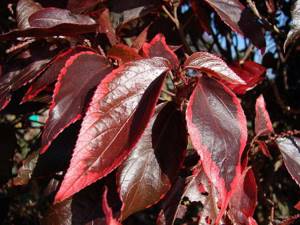
Acalypha godseffiana photo
A hybrid notable for the beauty of its leaves. The leaf plates are round in shape, the edges are carved, they are bordered by a stripe of golden, bronze, or less often white. The main tone of the leaf is green; forms that can change shade to burgundy when exposed to bright light deserve special attention.
Home care rules
Home care for fox tail varies depending on the season of the year.
| Season | Lighting | Humidity level | Temperature |
| Spring | Needs bright but diffused light. It is preferable to install a pot with a plant in a room, on east or west windows. When placed on the south side, you will have to protect it from direct sunlight. | More than 70%. If possible, the plant should be sprayed as often as possible. It is better to place the container with acalypha in a tray with wet pebbles. | The plant prefers to grow in warm conditions, so the temperature should be +20-25 degrees. |
| Summer | Bright lighting, without exposure to direct sunlight. | ||
| Autumn | Humidity from 70%. Akalifa is not recommended to be placed near heaters. It is recommended to humidify the air using all possible methods. | The optimal temperature is +18 degrees. At +15 degrees, the plant will die. | |
| Winter | The lighting should be intense, and you may have to use artificial devices. With a lack of light, variegated varieties of Akalifa will lose their color. |
Plant care
Akalifa is a tropical plant, so it is recommended to grow it in well-lit rooms. In winter, the plant can be exposed to the sun. In summer, the flower is shaded; when planting, a place is chosen where direct sunlight will minimally fall on the leaves of the akalifa.
The soil should be slightly acidic and well fertilized. In uninhabited soils, the plant will be small and weakly flowering and will soon die without feeding. A good layer of drainage is poured into the pots, peat, sand and turf soil are mixed.
For long-term species growing in greenhouses and rooms, it is recommended to maintain the following temperature conditions:
- In winter, the temperature should not drop below 17 degrees.
- The optimal air temperature should be between 22-25 degrees.
Watering the plant:
- You need to pay special attention to watering. The soil should always be wet, but overwatering the plant is prohibited. Based on this, the watering process is carried out as the soil dries out.
- In winter it is reduced.
- In addition, during operation of the heating units, it is recommended to systematically spray the flower from a spray bottle with water at room temperature.
- It is also possible to temporarily place the pot on a tray with wet sand or moss.
Every year in spring and summer, when the plant is in the active growth phase, it is recommended to apply mineral and organic fertilizers. Fertilize once every 2 seven days.
Replant adult plants as needed.
In addition, it is possible to leave the bush in a dilapidated tub, changing only the top part of the soil. To do this, it is loosened and carefully removed in parts so as not to damage the root system. Fertilizers are applied to the remaining part, and the other part is covered with prepared substrate. Young plants are replanted every year until they are 5 years old.
Along with this, the diameter of the pot increases every time and the soil is completely replaced.
Gardeners recommend rejuvenating the bush once every 4-5 years. Along with this, the bush is pruned. The entire above-ground part is reduced so that branches up to 30 cm from the ground remain.
Capacity, soil, replanting, pruning
A clay or plastic wide pot is suitable for growing akalifa. Light and porous soil is placed in this container; the approximate composition is as follows:
| River sand, peat, leaf and turf soil | In equal proportions |
| Peat, turf soil, river sand and humus | In equal quantities |

Young plants need to be replanted in the spring. For adult acalyphs, the growing container and soil are changed every three to four years. The transplant is carried out according to the following plan:
- the pot is disinfected, a drainage layer consisting of expanded clay, fine crushed stone, foam chips and brick is placed in the container;
- the height of the drainage layer is two to three centimeters;
- wear protective gloves, since the sap of the plant is poisonous;
- the fox tail is carefully removed from the old pot, the earthen lump must be preserved, and damaged areas of the roots are removed;
- the plant is installed in the center of the new container; while filling the soil, the pot needs to be shaken a little and the soil compacted;
- then watered, placed in a permanent place and sprayed.
To increase the splendor of the bush, during the growing season it is necessary to pinch the shoots on the two upper buds two or three times.
Reproduction of creeping Akalifa
This type of akalifa reproduces even more easily than its relatives. While the main method of obtaining foxtail remains growing from seeds, cuttings of the oak-leaved acalypha are most often rooted. The dense branching of numerous shoots allows you to obtain dozens of cuttings without harm to the mother plant.
It is enough to cut off the top of a strong shoot with two pairs of leaves and root it under a cover in any light sandy substrate. The shoots take root most quickly in March, but if protected from the heat (the optimal temperature for rooting is 21 degrees), reproduction will be possible at any time of the year with only a slight loss in the percentage of “effectiveness”.
Growing errors and pests
When growing foxtail, inexperienced gardeners can make a number of mistakes, the negative effects of which are enhanced by the action of pests:
| Errors in cultivation/Causes | Pests/Possible Damage |
| Stretching of stems, reduction in foliage size - insufficient lighting. | Small beige dots form on the foliage - aphids. |
| Yellow and brown leaves, drying tips - frequent drying out of the soil in the container. | A barely noticeable spot of irregular shape appears on the leaves - whiteflies. |
| The formation of a wrinkled surface on the foliage is a result of non-compliance with the watering regime. | There is a thin and barely noticeable thread on the petioles and stem; whitish spots are formed on the underside of the foliage - spider mites. |
| The appearance of brown, wet spots on the foliage is due to excessive watering and low air temperature. | The plant is covered with small dirty-white lumps that resemble fluff and cotton wool - mealybugs. |
| Drying and falling leaves means the plant is not sufficiently fertilized and lacks nutrients. | Yellow and red spots on the foliage are scale insects. |

Pest control is carried out using special insecticides.
Diseases and pests
If the grower pays close attention to the flower, then the akalifa will rarely get sick. If you do not treat the plant properly, you may encounter the following problems:
- Falling leaves. The cause of this disease is low indoor air temperature. When it increases, akalifa will again delight with its rich color.
- The leaves turned yellow. This means that there is low air humidity in the room where the flower is located.
- The growth of the plant is accompanied by paleness of the leaves. This problem occurs due to a lack of light in the room.
- Spots appeared on the leaves. The appearance of spots indicates that a fungus has appeared on the flower. To destroy the fungus from the leaves, it is recommended to treat them with a funcid.
- Slow plant growth. This indicates that there is not enough nitrogen in the soil. To restore the lack of nitrogen in the soil, you need to dilute one gram of urea per liter of water and water the plant with the resulting solution.
Like many plants, akalifa faces harmful insects, such as:
- aphid;
- scale insect;
- mealybugs.
You can get rid of the pest as follows:
- Shield.
This small insect sucks the life juice from the leaves, stems and fruits of the flower. After its defeat, red or yellow spots remain, and the affected areas die off over time. To prevent their occurrence, it is necessary to do frequent inspections in late winter and early spring. It is also recommended to spray the flower with water and ventilate it frequently. To get rid of scale insects, they are collected, and the affected areas are cut off and treated with chemicals (for example: Actellik, Fitoferm or Arrivo). - Aphid.
This pest is found on the plant much more often than all others. A soap solution helps in the fight against it. You need to dilute a piece of laundry soap with 1 liter of water, and then treat the affected areas of the plant. - Scaleworms. Getting rid of such a pest is not easy; for this it is necessary to take comprehensive measures.
First, you need to wipe the leaves of the flower with soapy water to remove the waxy coating.You will also need chemical treatment using such means as: Fitoferm, Metaphos, etc.
When processing a flower, do not wipe the leaves with just a cotton swab, as this can transfer the insect to unaffected areas.
There are many varieties of this plant, so finding one that you like is not difficult. And proper flower care will help you get lushly blooming acalypha all year round. To do this, it is enough to monitor the health of the flower and get rid of pests in time.
Mr. Summer resident explains: poison or medicine?
Astrologers and people who follow the teachings of Feng Shui find this plant very useful, noting that akalifa has a good effect on the cardiovascular system.
In addition, the flower fills the house with positive energy, improving the mood of its owners. Previously, it was fashionable to give a flower to a partner or life partner, because it added strength of spirit to a person.
Despite the fact that akalifa looks like nettle, it will be an excellent decoration for the interior, and it can also be used for landscaping a summer cottage.
The main thing is to carefully care for the plant and wear rubber gloves when removing weeds, as there is a possibility of toxic juice getting on the skin and causing allergies.


